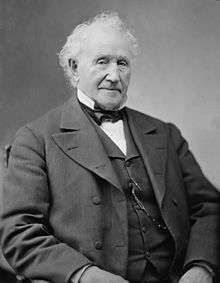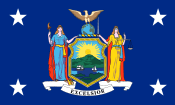George W. Patterson
| George W. Patterson | |
|---|---|
 | |
| Member of the U.S. House of Representatives from New York's 33rd district | |
|
In office March 4, 1877 – March 3, 1879 | |
| Preceded by | Nelson I. Norton |
| Succeeded by | Henry Van Aernam |
| Lieutenant Governor of New York | |
|
In office 1849–1850 | |
| Governor | Hamilton Fish |
| Preceded by | Hamilton Fish |
| Succeeded by | Sanford E. Church |
| Member of the New York State Assembly | |
|
In office 1832, 1833, 1835 – 1840 | |
| Preceded by | Luther Bradish |
| Succeeded by | Peter B. Porter, Jr. |
| Personal details | |
| Born |
November 11, 1799 Londonderry, New Hampshire, U.S. |
| Died |
October 15, 1879 (aged 79) Westfield, New York, U.S. |
| Resting place |
Westfield Cemetery Westfield, New York |
| Citizenship | US |
| Political party | Republican |
| Spouse(s) | Hannah Dickey Patterson |
| Relations |
William Patterson Augustus Frank |
| Children |
George W. Patterson Hannah Whiting Patterson |
| Parents |
Thomas Patterson Elizabeth (Wallace) Patterson |
| Alma mater | Pinkerton Academy |
| Profession |
Farmer Manufacturer Politician |
George Washington Patterson (November 11, 1799 – October 15, 1879) was an American politician in the U.S. State of New York. He served as a member of the United States House of Representatives and as Lieutenant Governor of New York during the 1800s.
Early life
Born in Londonderry, Rockingham County, New Hampshire, Patterson was the youngest of twelve children born to Thomas and Elizabeth (Wallace) Patterson. He received a common school education and graduated from Pinkerton Academy. At the age of 18 he taught school in New Hampshire for three months before moving to Livingston, New York with his older brother, where they ran a successful business dealing with the manufacture and sale of fanning mills.[1]
Career
Patterson engaged in the manufacture of fanning mills in Genesee County until 1825 when he settled in Leicester, Livingston County, New York and engaged in agricultural pursuits and the manufacture of farming implements. He was commissioner of highways of Leicester, and a justice of the peace.[2]
He served as a member of the New York State Assembly from Livingston County in 1832, 1833, and from 1835 to 1840;[3] Patterson was Speaker in 1839 and 1840.[4] He was basin commissioner at Albany in 1839 and 1840. He moved to Westfield in 1841 to take charge of the Chautauqua land office.[5] He was a delegate to the New York State Constitutional Convention in 1846.
Patterson was Lieutenant Governor of New York from 1849 to 1850,[6] and chairman of the harbor commission at New York from 1855 to 1857. He was quarantine commissioner of the Port of New York in 1859, and was supervisor and president of the board of education for many years. He was a delegate to the Republican National Conventions of 1856 and 1860.[7][8]
Elected as a Republican candidate to the Forty-fifth United States Congress, Patterson was United States Representative for the thirty-third district of New York from March 4, 1877 to March 3, 1879.[9]
Death
Patterson died in Westfield, New York, on October 15, 1879 (age 79 years, 338 days).[10] He is interred at Westfield Cemetery in Westfield, New York.
Family life
In February 1825, he married Hannah Dickey[11] and they had one son, George W. Patterson; and a daughter, Hannah Whiting Patterson.[12] Both his brother William Patterson[13] and his nephew Augustus Frank were also United States Representatives from New York.[14]
References
- ↑ "George W. Patterson". 2014 - Chautauqua County Historical Society. Retrieved 4 March 2014.
- ↑ Livingston County Historical Society, Geneseo, N.Y (1880). Annual Meeting of the Livingston County Historical Society. Livingston County Historical Society, Geneseo, N.Y. p. 7.
- ↑ "Patterson Family papers". Patterson Family papers, Bentley Historical Library, University of Michigan. Retrieved March 6, 2014.
- ↑ United States. Government Printing Office (1918). Congressional serial set. U.S. G.P.O. p. 910.
- ↑ "George W. Patterson collection". George W. Patterson collection, William L. Clements Library, The University of Michigan. Retrieved March 6, 2014.
- ↑ Alexander, DeAlva Stanwood. A Political History of the State of New York volume 2. Millibuch & Co. p. 117.
- ↑ Greeley, Horace (1893). Proceedings of the First Three Republican National Conventions of 1856, 1860 and 1864: Including Proceedings of the Antecedent National Convention Held at Pittsburg, in February, 1856. C.W. Johnson. p. 184.
- ↑ United States. Government Printing Office (1918). Congressional serial set. U.S. G.P.O. p. 910.
- ↑ Edson, Obed. Biographical and portrait cyclopedia of Chautauqua County, New York. Gresham, 1891 - History. pp. 55–57.
- ↑ "Patterson Family papers". Patterson Family papers, Bentley Historical Library, University of Michigan. Retrieved March 6, 2014.
- ↑ "George Patterson – Bicentennial Biography No. 197". Chautauqua County Historical Society. Retrieved March 6, 2014.
- ↑ "George W. Patterson collection". George W. Patterson collection, William L. Clements Library, The University of Michigan. Retrieved March 6, 2014.
- ↑ "PATTERSON, William, (1789 - 1838)". Biographical Directory of the United States Congress. Retrieved March 6, 2014.
- ↑ "FRANK, Augustus, (1826 - 1895)". Biographical Directory of the United States Congress. Retrieved March 6, 2014.
External links
| Wikimedia Commons has media related to George W. Patterson. |
- United States Congress. "George W. Patterson (id: P000116)". Biographical Directory of the United States Congress.
- Find A Grave
| Political offices | ||
|---|---|---|
| Preceded by Luther Bradish |
Speaker of the New York State Assembly 1839–1840 |
Succeeded by Peter B. Porter, Jr. |
| Preceded by Hamilton Fish |
Lieutenant Governor of New York 1849–1850 |
Succeeded by Sanford E. Church |
| United States House of Representatives | ||
| Preceded by Nelson I. Norton |
Member of the U.S. House of Representatives from New York's 33rd congressional district 1877–1879 |
Succeeded by Henry Van Aernam |
